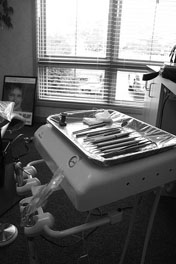Many of us dread visiting the dentist, but a new survey suggests that Americans are concerned about access to affordable dental care and that a majority support the use of alternative dental providers.

Photo by Sean Lamb via Flickr
More than 52 million people live in 4,675 federally qualified dental shortage areas where many face obstacles to receiving care because of the high cost of dental services, a shortage of dentists and a lack of dental insurance coverage. It would take 10,242 new practitioners to meet their dental needs, according to the Health Resources and Services Administration.
The survey released Tuesday examines Americans’ barriers to dental care and asks them whether they would support dental therapists and other mid-level dental providers, who generally receive 3,000 hours of training, to provide routine care like cleanings and fillings, to make care more accessible. Seventy-eight percent of respondents said they would support the training of such dental practitioners to provide preventative, routine dental care to people without regular access to care.
The survey was sponsored by the W. K. Kellogg Foundation, which last November launched a major dental care initiative and is working to strengthen the role of dental therapists in Ohio, New Mexico, Kansas, Washington and Vermont.
“It’s exciting to see the recognition that a dental therapist or middle level provider can make a difference to people. It’s both the recognition of the problem and the recognition that there’s a solution out there,” said David Jordan, a project partner at the national health advocacy organization Community Catalyst. The survey is the first national one to ask about support for dental therapy, Jordan said.
Other key findings include:
• Forty-one percent of respondents said that they have put off dental care in the past 12 months due to costs. People most likely to put off care because of costs include those with incomes less than $30,000, Latinos, people without dental insurance, and those with a high school diploma or less.
• Thirty percent said they do not have a place to receive regular dental care.
• Eighty-four percent think that it is a problem that so many Americans cannot afford dental care and 82 percent believe it is “very” or “somewhat hard” for people to get free or low-cost dental care in their communities.
• Forty-percent of respondents do not currently have dental coverage.
Raymond F. Gist, president of the American Dental Association, responded in a release, “Unfortunately, there is no single or simple solution. Barriers to oral health vary from region to region, state to state, city to city.” He also criticized the Kellogg Foundation’s “narrow focus” on dental therapists and raised questions about the dental therapists’ level of training and the cost of their care as well as whether they would work with dentists nearby and perform surgical procedures.
A July 2011 report by the Institute of Medicine (IOM) on oral health found millions of Americans face “persistent and systemic” barriers that limit their access. And an Ohio poll conducted last April found 66 percent of respondents supported changing Ohio state law to allow trained dental technicians to perform routine dental procedures.
“The process in Ohio as in most other states is difficult primarily because organized dentistry is so clearly in opposition to the position,” said David Maywhoor at Universal Health Care Action Network (UHCAN) Ohio. “So it’s really critical that voters to come forward and say they’re ready for change.”
Having started with Alaskan Native communities in 2005, dental therapy is often associated as a care model for Native Americans, but has been gaining interest elsewhere in recent years. Minnesota recently passed legislature to establish dental therapists as a part of the dental team, and a number of states are considering legislation to allow dental therapists to be trained and licensed, an effort that requires changes to state scope of practice laws.
“For so long, with oral health advocacy, the table was controlled by the dental associations and organized dentistry, and that’s where a lot of the policy was dictated from,” said Jordan, who likened dental therapists to other mid-level providers like physician assistants or nurse practitioners. “There is growing momentum to this approach and it’s really being driven by people on the ground who don’t have access to dental care and our state partners are really helping to give them a voice.”
The poll, conducted by Lake Research Partners for the Kellogg Foundation, surveyed 1,023 adults between July 12-18 and has a margin of error of +/- 3.1 percent.






